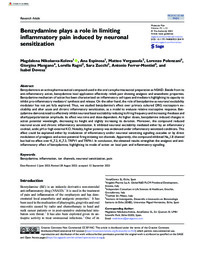Título :
Benzydamine plays a role in limiting
inflammatory pain induced by neuronal
sensitization |
Autor :
Nikolaeva-Koleva, Magdalena 
ESPINOSA, ANA 
VERGASSOLA, MATTEO
Polenzani, Lorenzo 
Mangano, Giorgina 
Ragni, Lorella
Zucchi, Sara 
Ferrer-Montiel, Antonio 
Devesa Giner, Isabel  |
Editor :
SAGE Publications |
Departamento:
Departamentos de la UMH::Bioquímica y Biología Molecular |
Fecha de publicación:
2023-09 |
URI :
https://hdl.handle.net/11000/35273 |
Resumen :
Benzydamine is an active pharmaceutical compound used in the oral care pharmaceutical preparation as NSAID. Beside from its
anti-inflammatory action, benzydamine local application effectively reliefs pain showing analgesic and anaesthetic properties.
Benzydamine mechanism of action has been characterized on inflammatory cell types and mediators highlighting its capacity to
inhibit pro-inflammatory mediators’ synthesis and release. On the other hand, the role of benzydamine as neuronal excitability
modulator has not yet fully explored. Thus, we studied benzydamine’s effect over primary cultured DRG nociceptors ex citability and after acute and chronic inflammatory sensitization, as a model to evaluate relative nociceptive response. Ben zydamine demonstrated to effectively inhibit neuronal basal excitability reducing its firing frequency and increasing rheobase and
afterhyperpolarization amplitude. Its effect was time and dose-dependent. At higher doses, benzydamine induced changes in
action potential wavelength, decreasing its height and slightly increasing its duration. Moreover, the compound reduced
neuronal acute and chronic inflammatory sensitization. It inhibited neuronal excitability mediated either by an inflammatory
cocktail, acidic pH or high external KCl. Notably, higher potency was evidenced under inflammatory sensitized conditions. This
effect could be explained either by modulation of inflammatory and/or neuronal sensitizing signalling cascades or by direct
modulation of proalgesic and action potential firing initiating ion channels. Apparently, the compound inhibited Nav1.8 channel
but had no effect over Kv7.2, Kv7.3, TRPV1 and TRPA1. In conclusion, the obtained results strengthen the analgesic and anti inflammatory effect of benzydamine, highlighting its mode of action on local pain and inflammatory signallin
|
Palabras clave/Materias:
Benzydamine
inflammation
ion channels
neuronal sensitization
pain |
Área de conocimiento :
CDU: Ciencias puras y naturales: Biología: Bioquímica. Biología molecular. Biofísica |
Tipo de documento :
info:eu-repo/semantics/article |
Derechos de acceso:
info:eu-repo/semantics/openAccess
Attribution-NonCommercial-NoDerivatives 4.0 Internacional |
DOI :
https://doi.org/10.1177/17448069231204 |
Publicado en:
Molecular Pain
Volume 19: 1–12 (2023) |
Aparece en las colecciones:
Artículos - Bioquímica y Biología Molecular
|
 La licencia se describe como: Atribución-NonComercial-NoDerivada 4.0 Internacional.
La licencia se describe como: Atribución-NonComercial-NoDerivada 4.0 Internacional.
.png)
